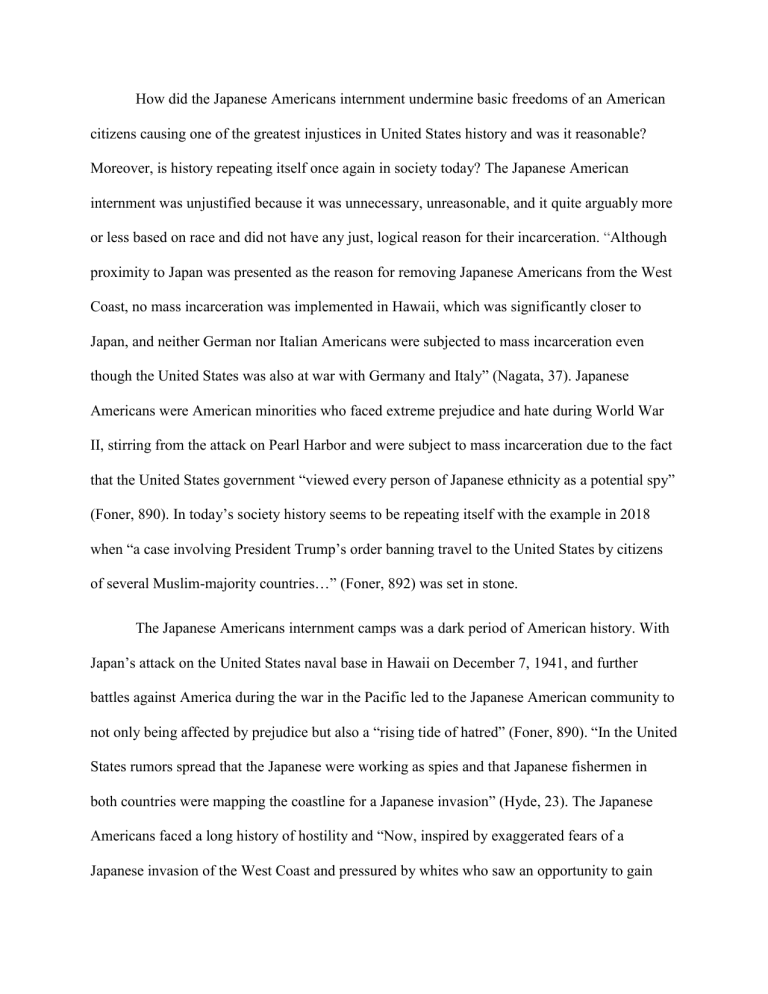
How did the Japanese Americans internment undermine basic freedoms of an American citizens causing one of the greatest injustices in United States history and was it reasonable? Moreover, is history repeating itself once again in society today? The Japanese American internment was unjustified because it was unnecessary, unreasonable, and it quite arguably more or less based on race and did not have any just, logical reason for their incarceration. “Although proximity to Japan was presented as the reason for removing Japanese Americans from the West Coast, no mass incarceration was implemented in Hawaii, which was significantly closer to Japan, and neither German nor Italian Americans were subjected to mass incarceration even though the United States was also at war with Germany and Italy” (Nagata, 37). Japanese Americans were American minorities who faced extreme prejudice and hate during World War II, stirring from the attack on Pearl Harbor and were subject to mass incarceration due to the fact that the United States government “viewed every person of Japanese ethnicity as a potential spy” (Foner, 890). In today’s society history seems to be repeating itself with the example in 2018 when “a case involving President Trump’s order banning travel to the United States by citizens of several Muslim-majority countries…” (Foner, 892) was set in stone. The Japanese Americans internment camps was a dark period of American history. With Japan’s attack on the United States naval base in Hawaii on December 7, 1941, and further battles against America during the war in the Pacific led to the Japanese American community to not only being affected by prejudice but also a “rising tide of hatred” (Foner, 890). “In the United States rumors spread that the Japanese were working as spies and that Japanese fishermen in both countries were mapping the coastline for a Japanese invasion” (Hyde, 23). The Japanese Americans faced a long history of hostility and “Now, inspired by exaggerated fears of a Japanese invasion of the West Coast and pressured by whites who saw an opportunity to gain possession of Japanese American property, the military persuaded President Franklin D. Roosevelt to issue an Executive Order 9066” (Foner, 891). This ordered made in February 1942, ordered the relocation of all persons of the Japanese descent from the West Coast in an attempt to suppress supposed espionage and sabotage attempts on the part of the Japanese government. Not only was the incarceration of the Japanese Americans based on false ideas and shaky evidence, but it also violated the rights of Japanese Americans through processes of institutional racism and prejudice that were imposed following the events of Pearl Harbor. “Racially charged post-Pearl Harbor fears and the economic self-interests of agricultural groups who would profit by taking over lands farmed by Japanese Americans played important roles in the calls for removal (Nagata, 37). More than 110,000 Japanese Americans were removed and two-thirds of them were American citizens. “One third were first generation immigrants, or issei, but a substantial majority were nisei – American born, and therefore citizens” (Foner, 890). Although some of the Japanese Americans were American citizens, Japanese Americans did not receive equal protection under the law, in spite of the Fourteenth Amendment of the Constitution. The internees were subjected to a quasi-military discipline in the camps, living in former horse stables, makeshift shacks, or barracks behind barbed wire fences and having to deal with a poorly equipped community and crowded living situations. There were constantly under watch with armed guards patrolling the camps and searchlights shone all night. Privacy, medical facilities, nutrition, education and plumbing were basically nonexistent. On top of all that, the internment camps were purposely located in areas far away from other cities and surrounded by harsh landscapes. This was to ensure that contact with the outside world and all possibilities of escape were kept to an absolute minimum. The Japanese Americans were treated almost indirectly as prisoners for four years in harsh living conditions and lost most to all their property based off racism and fear, even though two thirds of the Japanese Americans were American citizens and could not even speak Japanese and had never even been to Japan. “They had lost all the money and property they had worked years to build up. Now they were living in poverty again” (Hyde, 29). The reasons for incarceration were not justified for the level of suffering coupled with mental and physical stress due to forced confinement the Japanese Americans had to undergo. “Internment revealed how easily war can undermine basic freedoms” (Foner, 892). No court hearings, no due process, and no writs of habeas corpus were done to stand against “...the gravest violation of civil liberties since the end of slavery” (Foner, 892). Press supported the policy while groups publicly committed to fighting discrimination from the Communist party to the NAACP and the American Jewish Committee, either defended the policy or remained silent. The courts refused to intervene but even when these outrageous injustices were brought to the country’s highest court in the 1944 case Korematsu v. United States, the Supreme Court justices denied the appeal of Fred Korematsu and ruled that “military necessity” outweighed the civil rights of Japanese Americans. “The Bill of Rights” was almost completely violated with the Japanese Americans internment, and all for what? Shady rumors and culture of fear coupled with prejudice and racism? There was no reasonable and just reason for this mass incarceration. Although the Supreme Court declared that the Korematsu decision was “gravely wrong” and Congress issued a formal apology in 1988, did they really learn from their mistakes? “In the United States, several of the camp locations have been preserved as historical landmarks. Congress said this was to “stand as reminders that this nation failed in its most sacred duty to protect its citizens against prejudice, greed, and political expediency.” (Hyde, 38). In todays society Japanese American prejudice has listened quite a bit but other groups of people are becoming targets of the same fear and hate such as Muslims due to all the terrorist attacks around the world by extremist. The events of 9/11 produced the same fear and hate the Japanese Americans experienced form Pearl Harbor. In 2019 President Trumps’ order banning travel to the United States by citizens of several Muslim-majority countries could be seen as history repeating itself. The same mistrust is now being applied to the Muslims and their mosques are now being vandalized and Muslims themselves threatened and harassed. “They question their loyalty. They dislike the cultural differences. They have not interned Muslims, but many places in the world are turning back refugees because they are Muslims” (Hyde, 40). Japanese Americans suffered a great deal from prejudice, unnecessary fear, harsh treatment and unjust incarceration all for unreasonable reasons. “Later investigations would conclude that the incarceration decision was not a justified military necessity but was instead shaped by “race prejudice, war hysteria, and a failure of political leadership”” (Nagata, 37). Moreover, the Muslims are considered the new “enemy aliens” in todays society and even though the American Government claims to have been wrong during the Japanese American interment, will they learn from their mistakes and protect its citizens against prejudice, greed, and political expediency? “Those who have been through the times of internment of Japanese, Germans, Italians, Ukrainians, and Jews wonder if we will repeat our mistakes because we have forgotten the past” (Hyde, 40). Works Cited Foner, Eric. Give Me Liberty! : an American History / Eric Foner. 6th ed., vol. 2, New York : W.W Norton & Company, 2019. Hyde, Natalie. Internment Camps. Crabtree Publishing Company, 2016. EBSCOhost, search.ebscohost.com/login.aspx?direct=true&AuthType=shib&db=nlebk&AN=1796550&site= eds-live. Nagata, Donna K., et al. “The Japanese American Wartime Incarceration: Examining the Scope of Racial Trauma.” American Psychologist, vol. 74, no. 1, Jan. 2019, pp. 36– 48. EBSCOhost, doi:10.1037/amp0000303.




